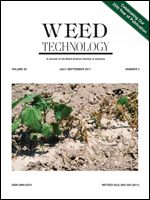Miscanthus is a perennial, rhizomatous C4 grass grown in the European Union and studied in the United States as a bioenergy feedstock. U.S. farmers might be more willing to grow this perennial species if methods for its control were established. Experiments were conducted from 2007 to 2009 to evaluate methods to control miscanthus. As glyphosate rate increased from 0 to 3.6 kg ae ha−1 in a greenhouse trial, miscanthus dry weight decreased. Aboveground biomass in the summer following treatments decreased 82, 77, and 95% with fall, spring, and fall followed by spring applications of glyphosate (1.7 kg ae ha−1), respectively, compared with nontreated plots in field experiments. Summer shoot count was reduced by 41% compared with the nontreated control with fall followed by spring glyphosate applications. A second field experiment demonstrated that spring tillage with one or two spring glyphosate applications (2.5 kg ae ha−1 application−1) reduced aboveground dry biomass by 94 and 95%, respectively, and reduced miscanthus shoot number by 38 and 67%, respectively, in the same growing season. These experiments suggest that although glyphosate and tillage can reduce miscanthus biomass, complete control of a mature stand likely will require more than one growing season.
Nomenclature: Glyphosate, Miscanthus × giganteus Greef and Deuter ex Hodkinson and Renvoize.






